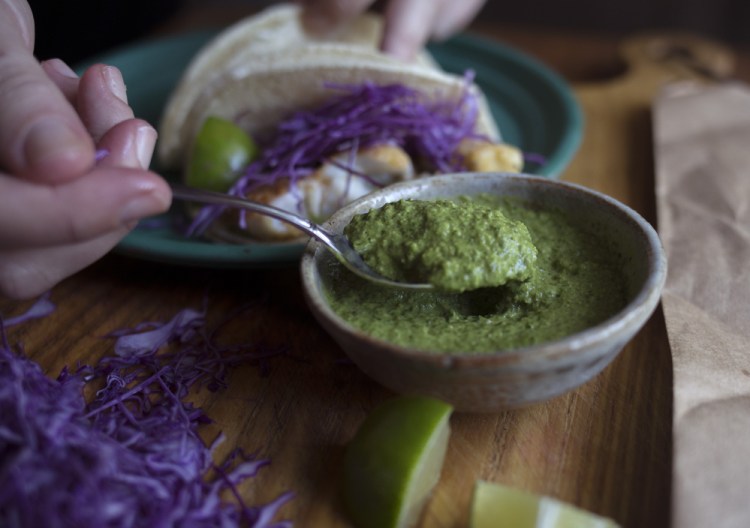There are few days when I don’t have time to talk about food with anyone who happens to ask. At the dentist’s office last week, I put down the mind candy People magazine was offering to chat with the receptionist about pesto.
“It says on the label not to heat it up. Can I bake with it? It’s kind of expensive and I don’t want to waste it,” she said.
The short answer: certainly. The warning was likely meant to stop cooks from simmering the commercial paste in a saucepan, a process that would turn the basil black and the cheese clumpy and erase the pesto’s bright, summery taste. Those conditions don’t apply if pesto is one of the layers in your summer vegetable lasagna.
You can control for basil oxidation and cheese congealment if you make your own, I continued. You can blanch the basil or mix it with parsley to keep the color vibrant and you can hold back on the cheese until you’re sure the pesto is bound for the pasta bowl.
Can you give me a recipe? I could, but it’s more sustainable to think of making pesto as a ratio-based operation so you can create as many dishes as you’d like with the ingredients you have on hand (or need to use up) at any given time.
Most people think of pesto as the classic Genovese combination of basil, pine nuts, garlic, olive oil and grated cheese traditionally pounded to a paste with a mortar and pestle. But in truth, it’s just a means by which you can preserve the fresh herbs abundant at this time of year with a variety of other ingredients into a mixture that can be tossed with everything from agnolotti to ziti and slathered on anything from crusty bread to grilled crustaceans.
Ratios are generally expressed with the largest quantity first and move on down the line. Recipe ingredient lists are generally written in the order in which they are used in the recipe first, and according to descending quantities second. So this ratio recipes pulls a bit from both structures and goes something like this: 3 cups to up to 1 cup; to 1/3 cup; to 1 garlic clove; to 1/2 cup; to 1/2 cup; to taste. Easy as paste, I say.
The first component is always going to be the herbs (basil, cilantro, mint, oregano, parsley, thyme) and greens (arugula, beet greens, chard, kale, mustard greens, spinach) in some combination. You’ll need 3 loosely packed cups altogether of these.
Many pestos contain a secondary flavor component – mainly a sweeter one like corn, peas, roasted red peppers or sun-dried tomatoes. I hold these elements to 1 cup to keep fresh herbs as the stars.
Next, the nuts. Pignoli (the Italian word for pine nuts) are traditional, but expensive because it’s a pretty arduous process to take the seeds from the pine cone and then shell them. While no nut is wholly sustainable given their water requirements and travel times to Maine, walnuts, pistachios, almonds and pecans as well as some seeds like pepitas and sunflowers work well in pesto, too. You’ll need 1/3cup. Toasting releases their oils, thereby boosting the flavor for a relatively small volume.
The pungency of pesto comes from the garlic, but how strong your clove is will vary. I start with 1 large one and move up as I need to, but I rarely do.
All of these ingredients get mashed together (using a mortar and pestle if you’ve got a big one or a food processor if you don’t), before 1/2 cup oil – traditionally olive oil if your herbs are strong but you can use more neutral ones if your herbs are more timid – gets processed in next.
You taste the pesto at this juncture, adding lemon zest and juice to lighten its taste if necessary and a pinch of cayenne if it needs heat.
Only add the cheese – 1/2 cup of a grated hard one – if you are going to put the pesto in the refrigerator and use it up within a few days. If you plan to freeze it – and you can do so for up to six months – it’s best to do so without the cheese; ice cube trays are great for this job. Add 1 tablespoon of cheese to every cube of thawed pesto when you use it, whenever that may be.
Christine Burns Rudalevige is a food writer, a recipe developer and tester, and a cooking teacher in Brunswick. Contact her at: cburn1227@gmail.com.
Send questions/comments to the editors.




Success. Please wait for the page to reload. If the page does not reload within 5 seconds, please refresh the page.
Enter your email and password to access comments.
Hi, to comment on stories you must . This profile is in addition to your subscription and website login.
Already have a commenting profile? .
Invalid username/password.
Please check your email to confirm and complete your registration.
Only subscribers are eligible to post comments. Please subscribe or login first for digital access. Here’s why.
Use the form below to reset your password. When you've submitted your account email, we will send an email with a reset code.